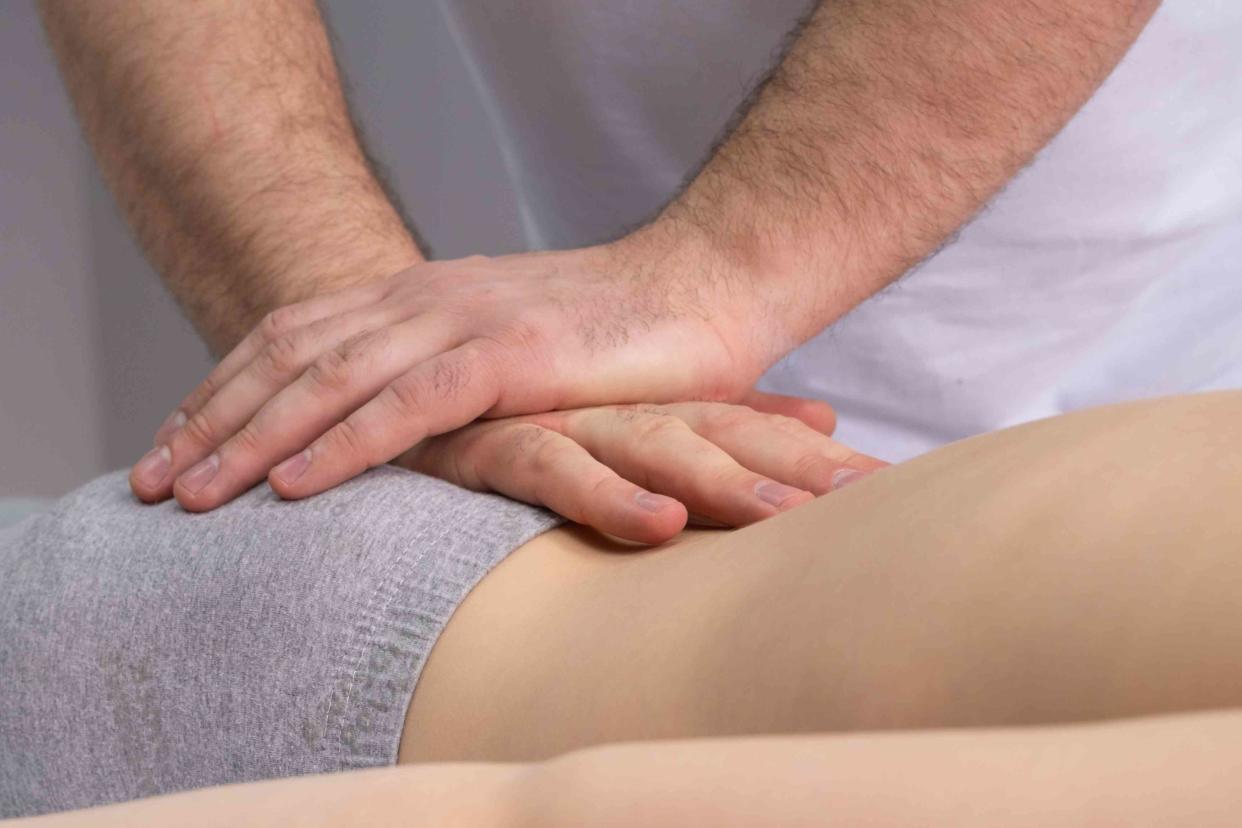Tailbone Pain (Coccydynia)

Dina Damotseva / Getty Images
Medically reviewed by Amy Kwan, PT, DPT
The coccyx (tailbone) is located below the hips at the end of the spine. "Coccydynia" is the medical term to describe pain in the tailbone area. Coccyx pain has various causes, such as pregnancy or childbirth, falling on the area, or sitting for prolonged periods.
Learn about coccydynia, the possible causes, treatment options, and more.

Dina Damotseva / Getty Images
Symptoms of Coccydynia
The primary symptom of coccydynia is pain. Specific factors can contribute to the pain, including the following:
Sitting, especially on a hard surface
Standing from a seated position
Certain activities (e.g., cycling)
Certain factors can trigger the pain, or it may be constant and range from mild to severe. People with coccydynia may experience swelling, especially if the coccyx is broken.
Types of Coccydynia
There are different types of coccydynia. The tailbone can be bruised, dislocated, or broken. A bruised bone is an injury that is less severe but may still require rest and limited movement or pressure, while a break is more severe and should be treated by a healthcare provider. Tailbone dislocation is rare, but it can happen.
The shape and position of the coccyx are classified into one of four types, as follows:
Type 1: There naturally is a slight forward curve of the coccyx.
Type 2: There is a moderate forward curve of the coccyx.
Type 3: There is a sharp forward angle of the coccyx.
Type 4: There is a dislocation or break of the coccyx.
Causes of Coccydynia
The most common cause of coccydynia is injury. This can happen when a person falls backward on their tailbone. Another common cause of tailbone pain is childbirth. Up to 15% of women experience coccydynia after giving birth; the coccyx can become bruised, dislocated, or broken during delivery. Poor posture and sitting too long can also cause tailbone pain.
Contributing factors to coccydynia include:
Being overweight or underweight
Cycling with pressure on the coccyx for too long
Excessively flexible joints
Falls or injury
A posture that puts extra strain on the coccyx
Sitting for a prolonged period, especially on hard surfaces
How to Treat Coccydynia
Anyone with moderate or severe tailbone pain or pain that persists for weeks should seek the support of a healthcare provider. Additionally, anyone with coccyx pain who faces challenges with urination or passing a bowel movement should seek professional care.
A healthcare provider may recommend rest and avoiding activities or positions that cause pain. They may suggest that you try sitting on a pillow if sitting on hard surfaces worsens your symptoms or medications to reduce pain and swelling. In rare cases, a healthcare provider will manually move a dislocated coccyx into place (manual reduction) or recommend surgery.
Treatment for coccydiynia includes:
Eating plenty of fiber
Icing the area
Maintaining a healthy weight
Having a manual reduction procedure
Medications for pain or swelling
Resting
Sitting on a pillow
Complications and Risk Factors Associated With Coccydynia
Women are more than twice as likely to experience coccydynia than men. Pregnancy and childbirth are risk factors for coccydynia. The fetus can put pressure on the tailbone, and childbirth can lead to injury of the coccyx. Additionally, women with coccydynia before pregnancy and delivery may face complications during pregnancy and birth.
Since injury is usually the cause of coccydynia, people who are at an increased risk of injury or falling are more likely to experience tailbone pain. One in 4 people over age 65 fall each year, thus putting this demographic at an increased risk for coccydynia. Athletes may also have an increased risk.
Are There Tests to Diagnose the Cause of Coccydynia?
Imaging is the best diagnosis of a dislocation or break that can cause coccydynia. A healthcare provider will recommend an X-ray to identify the cause of tailbone pain. If an X-ray does not provide enough detail for the provider to diagnose, they may order a computed tomography scan (CT scan) or magnetic resonance imaging (MRI) to identify the cause and determine an effective treatment.
When to See a Healthcare Provider
Without imaging, it may be difficult to tell if coccydynia is caused by a bruised, dislocated, or broken bone, making it difficult to determine a treatment plan. Coccydynia that does not go away within a few weeks may be chronic and should be evaluated by a healthcare professional.
Summary
Coccydynia is a pain in the coccyx (tailbone). It is typically caused by an injury that leads to bruising, dislocation, or a broken bone. It usually results from falling backward and landing on the coccyx, specific postures, or as an injury from childbirth. It generally goes away with rest and by limiting pressure on the area.
However, sometimes medical treatment is needed. If you experience pain for longer than a few weeks, seek the support of a healthcare provider.

